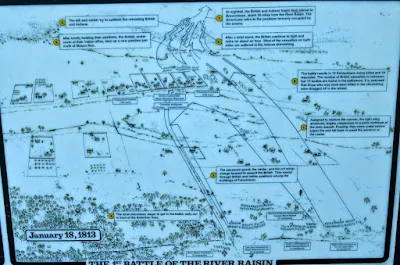I enjoyed the American Revolution battle problem so much, I cleared the table off of troops and brought my War of 1812 collection out. This should illustrate that the game can be fought out in any horse and musket period battle. This time the Americans are on the attack and the British/Canadian forces defending.
General Rial needed to hold the enemy for seven turns and withdraw his army to fight another day. Cautiously, he placed his regular infantry (41st, 49th and 100th Regiments and the Lincoln and York militia) back from the front, his guns forward and the native Indians in the woods opposed to the north ford and bridge. Once the enemy had started to cross he would move his infantry forward. Two regiments (100th and 49th) were to defend the south ford while the militia defended the north ford and bridge. In reserve he placed a troop of militia cavalry and the 41st Regiment.


General Brown commanded two Infantry Brigades. Scott's Brigade of the 9th, 11th US 22nd & 25th US Infantry and Ripley's Brigade of the 1st, 5th, 21st, 23rd US Infantry. The 1st US Rifle Regiment, three batteries of artillery and a troop of the New York State militia Dragoons rounded out his army. Rather then attempt an out flanking move he determined to bull through across the bridge and both fords. Scott would take his Brigade and cross at the lower ford while Ripley's brigade crossed at bridge. The Rifles, with the 5th US would move through the woods and cross at the northern ford. With overwhelming numbers and better troops (two of Scott's regiments were rated elite) they would capture the town and drive off the enemy easily.
Turns 1 & 2:
The Americans were surprised to find the woods covering the north ford undefended. The Rifles quickly moved through the woods to take position at the ford. More slowly the 5th US infantry with General Ripley followed. (Note: Skirmishes move full movement rate through woods while troops in formation move at half rate and get a DP each turn moving) Brown himself took the 1st US infantry across the bridge and deployed into line. The 21st US followed but both battalions found themselves under fire from Artillery and Indians to their flank.
Scott marched his Brigade forward and got two battalions (22nd and 25th US) across. But they too quickly came under musket and artillery fire. Worse, Scott was lightly wounded while steady his troops. (He lost 2 Command points) An unforseen occurrence was the movement of the infantry massed the artillery fire and the American guns stood useless!
Turns 3 & 4:
With part of there infantry across the southern ford and bridge the American commaners quickly tried to dress ranks and remove the DP's which were rapidly growing. (Notes: you can remove a DP by a commander spending Command points and also by halting for a turn)
The Rifles crossed the and spread out to protect the 5th as they crossed. At this point the British plan came into action. In the center cannister and musket fire disordered the 1st US (5 DP's). Here and at the north ford the militia charged the disordered troops in front. Although normally the militia would be handily defeated by the regulars he to the DP's the militia defeated both the 1st US infantry and 1st US Rifles. Routing backwards the regulars disordered the regiments behind them and the front line came to a halt.
The 100rd and 49th charged Scott's regiments which were in terrible shape. (Note: 5DP' s on one regiment and four on the other) The 25th US was destroyed in the fight with the 100rd and the 49th continued their fight with the 22nd US next turn. Scott, already wounded took yet another wound and was escorted off the field.
At this point, with the entire front falling apart Brown ordered his regiments to pull back. The surprised British and Canadians cheered and fired a salute. Their victory was totally unexpected.
Conclusion:
I like the changes to the rules. They clear up (to my mind) the confusion and provide a fast fun game. One point to remember is once you start to accumulate Disorder points things get out of hand. One or two are not bad but after three they seriously effect your Regiment. You subtract one dice per DP when firing and subtract two per each DP in close combat. After five DP you start removing stands of figures. This is what happened to the American side. Their front line regiments could not remove DP's fast enough and the enemy charged into regiments with four or more DP's.
I think if I fight this again I need to get another table to give myself a bigger battlefield! Also, by attempting to out flank the enemy up the road to the south you spread out the defender and make it harder for him to concentrate his forces against you. Just compare the last game to this one on who had the better plan.

























































